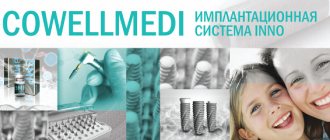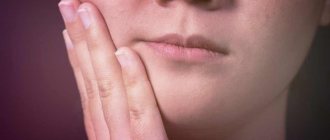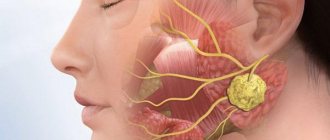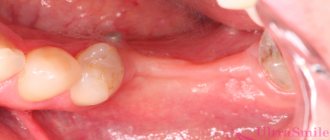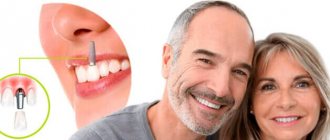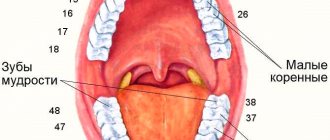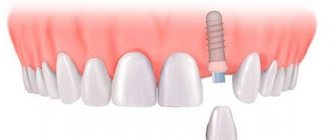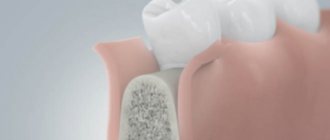In this material you will learn about the discovery of a new direction in science and medicine. By restarting the genetic program throughout a person’s life, it is possible to restore diseased organs, grow new teeth, and maintain the body’s energy in adulthood. The implementation of this new project will make it possible to naturally replace lost teeth many times over.
The essence of the project
A person, at his request, at any age, can naturally grow his own new ones in place of lost teeth.
How to achieve this? This can be done in any country, in an institute that deals with genetics and has sufficient suitable equipment. The starting point (base) for the development of this project is “A new theory of the origin, diversity and evolution of living organisms on Earth.”
Hereditary information is written in genes. From the moment of inception and further during the development of the organism, the embodiment (materialization into a solid body) of a complex, field energy-genetic program occurs. At a certain time, according to this program, a person grows his first (baby) teeth, and then his second (permanent) teeth. Later in life, for various reasons, it often happens that teeth are destroyed. And new ones don’t grow anymore.
Why don't new teeth grow? Because this is not included in the body’s life program. But the first program of tooth growth, like a recording on a magnetic tape, can be artificially reproduced.
Today, the human genetic code has been deciphered. It is known which gene is responsible for what. If in the body, in the DNA strand, the genes that are responsible for a particular tooth (teeth) are activated, then as a result it will be possible to grow new teeth at any time.
The process of “restarting reproduction” of certain genes can be carried out repeatedly and thus teeth can be grown many times at will. To do this, it is necessary, without changing the program in the slightest (change leads to deformity), each time to provide the genes with a sufficient amount of energy for growth.
Each gene, like a musical instrument, has its own “voice”, its own individual “sounding” frequency. The body, figuratively, is like a huge orchestra of a thousand instruments. In different people and different ages, the frequency of the “sounding” of the genes of the same name is different. The general characteristic would greatly simplify the mass production of devices for the growth of teeth and even entire organs. However, this will not prevent tuning to an individual frequency.
Innovative techniques
Since it became obvious that growing artificial organs was a practically accomplished fact, the question arose of how to do this faster and easier. Several completely new developments were proposed.
Introduction of stem cells
The technique has gained the greatest popularity in scientific circles. A number of actions that American specialists performed with the taken material made it possible not only to qualitatively recreate, but also to bring back to life the affected areas of the jaw row.
To achieve this, it is necessary to carry out certain molecular procedures with a set of stem tissues and plant them in the right place. Then, for some time, external intervention stops, and the tooth regenerates on its own.
The best option for such actions is brain cells or gum elements. The complexity of the theory is that its implementation is a complex process and difficult for a person to tolerate, and this complicates its direct application. But as for animals, the test results give stable positive dynamics of engraftment.
Exposure to ultrasound
Unlike the one discussed above, this procedure is not associated with pain. It was proposed by domestic scientists.
By pinpointing ultrasound flows to the site where a new body appears, pulsed stimulation of the area is carried out. It is done over a long period of time and purposefully.
The method is not as simple as it may seem, but it has the right to be developed, since to date no analogues have been found and is considered the most unique.
Scientists see in it great potential for the future, when the use of this technique will be widespread and ubiquitous.
Laser exposure
The idea that it is possible to influence the affected fragments with a laser and thus correct their regeneration processes was considered fantastic until recently.
However, the experiments conducted at the All-Russian Scientific Center for Stem Cells were successful, and after testing the cells of experimental animals, doctors revealed the appearance of completely new, full-fledged elements with the correct molecular structure and viability.
These tissues were obtained by laser. Its targeted impact activated the described processes, thus proving their consistency.
Then the same thing was repeated, but with cells taken from the human body. The result is that the material took root, began to recover and multiply, producing a new full-fledged mass.
How to implement
From the DNA sample it is necessary to read the energy wave characteristics of the desired gene (genes) and reproduce them with absolute accuracy from an external energy source.
A lightweight, inaudible portable device (the size of a cell phone) will emit the frequencies necessary to activate genes. You will need to carry this device with you for some time. The emitted frequency will cause a resonance of the energy wave of the gene (genes) in the body and provide them with the necessary “growth” energy.
By analogy, moving from the specific to the general, deepening the direction of gene activation, it will be possible to completely restore diseased organs (heart, lungs, kidneys, liver, eyes and all others). And in the future, in stationary conditions, we will grow native, new organs. Perhaps everything will be much simpler and more effective - it depends on the first results using the example of growing new teeth.
We can also talk about rejuvenating the body and increasing life expectancy. At 70-80 years old it will be possible to have the health and energy of 20 years of age.
For the first time in Moscow! Growing teeth from stem cells
Order on Aliexpress with delivery from Russia and up to 25% discount
Frankly, I am very sick of this kind of sensationalism, which periodically appears even in very serious publications. And even more interesting are all kinds of conspiracy theories, such as: “Dentists are specifically slowing down the implementation of growing teeth from stem cells because they are afraid of being left without work.” For goodness sake, but if it’s not dentists who do this, then who will perform such procedures?
Let's take a sober look at the technology of “growing teeth” from stem cells and evaluate its prospects.
Few people know that teeth are derivatives of epithelial tissues. Yes, teeth have a common origin with hair, nails and brains. Moreover, teeth are formed in a very, very specific way.
You know that a tooth consists of hard and soft tissues. Soft tissue is the pulp, in other words, the “nerve”, which is located inside the tooth, in a special cavity. The pulp is of mesenchymal origin, in other words, it is formed from a completely different embryonic layer and has nothing in common with enamel or cement. The pulp contains odontoblast cells that form dentin, as well as the vessels and nerve fibers that feed them. While teeth are forming, odontoblasts produce the so-called. primary dentin. After teething, this process proceeds very slowly (secondary dentin is formed), and in case of any damage to the tooth, the response is the formation of tertiary dentin on the side of the damage. In other words, dentin is capable of regeneration, since odontoblast cells remain throughout their lives in the pulp chamber.
The basis of the tooth, both in volume and weight, is dentin. It is a porous hard tissue, something like a honeycomb structure, in the channels of which there are processes of odontoblasts. As soon as caries reaches the dentin, the infection spreads very, very quickly along these same dentinal tubules and inflammation occurs in the tooth pulp, which we call pulpitis. That is why the development of pulpitis does NOT ALWAYS require direct communication between the carious cavity and the pulp chamber of the tooth.
Tooth enamel is the hardest tissue of the human body. It is much harder than steel and experiences incomparable loads. Enamel is formed by ameloblast cells, which, unlike odontoblasts, are present only during the period of tooth formation in the tooth germ, and disappear after tooth eruption. This is why enamel does not regenerate and is not restored when damaged (for example, due to caries). From a microscopic point of view, tooth enamel is very complex. It consists of three-dimensionally twisted so-called enamel prisms, the structure of which largely determines its strength and resistance to caries. Enamel covers the crown of the tooth, giving it its characteristic color and transparency. Therefore, the first sign of damage to the enamel, a violation of its structure, is a change in the color and transparency of the teeth.
The root of the tooth is covered with cement. Cementum is harder than dentin, but much softer than enamel. Cement is formed during the formation of teeth by cementoblast cells, a small amount of which remains in the periodontium even after teeth eruption. Cement, like enamel, is not capable of regeneration. Periodontal fibers are woven into the root cement - very strong connective tissue ligaments that seem to suspend the tooth in the socket. In other words, a healthy tooth does not have direct contact with the bone at all. The periodontium is needed to absorb the chewing load, and it also helps to nourish the cementum of the tooth root.
Cementoblasts, like ameloblasts, are of epithelial origin.
Why am I telling you all this? So that it becomes clear to you how complex each of your teeth is and how many tissues and cells are involved in its formation and development. Therefore, in order to recreate a full-fledged tooth from stem cells, we need to carry out the entire process of tooth formation in a test tube.
Now a little about stem cells.
Now even schoolchildren know that a stem cell is a protocell from which any cell in the body can be obtained. And that our blood contains a certain amount of these same stem cells in a “dormant” state.
That is, in order to grow something similar to an organ or tissue from stem cells, we need:
A)
isolate the required number of stem cells from the blood.
b)
force the stem cell to differentiate in the desired direction. In other words, we need to do something so that when it divides it turns into the cell we need - a hepatocyte, osteoblast, ameloblast, neuron, etc.
And, if modern science more or less copes with the first task, then the second task represents a serious problem.
Some time ago, mediators were discovered - special hormone-like substances that affect cell differentiation. By treating a stem cell culture with the desired mediator, you can force it to turn into liver, kidney or cartilage tissue - it all depends on which mediator is used. So, our body consists of hundreds of different cells, and mediators are open to only some of them. For example, mediators are known that cause a stem cell to transform into a hepatocyte (the main tissue of the liver) or an erythrocyte.
There is another way to force stem cells to divide in the desired direction. For example, plant a stem cell culture directly into an organ and wait to see what happens. It is on this method that the so-called. “stem cell therapy”, which is now widely promoted in medicine. It is difficult to talk about the clinical and reliable effectiveness of such methods, since it is still unclear whether anything grows there, if at all. Therefore, if you ever come across “cellular therapy,” especially in cosmetology, be careful. Well, we’ll talk about this as a separate topic someday.
Let's return to our sheep's teeth.
If we want to recreate a full-fledged tooth, we need to force the stem cells to divide in the right direction. So that they become: 1. Ameloblasts 2. Cementoblasts 3. Odontoblasts 4. Pulp fibroblasts, vascular cells, pulp nerve fibers 5. Periodontal fibroblasts
Moreover, our goal is not a shapeless cell culture. and the creation of an organ of a certain shape. In this regard, it is much easier to grow a liver or kidney from stem cells than a tooth. Because the shape of the liver, be it round or square, does not determine its performance, while the functionality of the tooth is determined primarily by its shape.
And here another problem appears. All teeth (and, if you remember, there are thirty-two of them) have different shapes, although they do not differ in cellular structure from each other. How to make a fang or a molar from a growing tooth? What determines its form and purpose? This question remains open and there is no clear opinion on it.
Let us suppose
, we managed to grow a tooth of the desired shape and size. And it's not just identical to a real tooth. He is alive! And now it needs to be transplanted into the place of the missing tooth.
For some time I was engaged in autologous dental transplantation. That is, I transplanted eights into the place of the removed sixth teeth and observed what would come of it. You can read more about this here>>. This technique has not received and will not receive clinical distribution (due to low clinical effectiveness), so my work in this direction can be attributed more to science than to practice.
I also often have to deal with dislocated teeth. And I can say that even if the tooth matches the socket perfectly, the healing process is not always successful. Although, sometimes everything works out very well.
It is clear that replanting a dislocated tooth or transplanting a wisdom tooth into a previously prepared socket is much easier than integrating a tooth grown in a test tube. However, we still have not learned how to implant dislocated teeth with a 100% guarantee, not to mention transplanting our own teeth! What kind of implantation of artificially grown teeth can we talk about?
That is, even if all obstacles are overcome and we are able to grow teeth in a test tube, the problem of integrating these teeth into a living organism will remain unresolved.
HOWEVER, there is a way out. You can transplant not a grown tooth, but, say, a tooth germ at an early stage. And then just wait for the tooth to erupt. It seems like everything is very simple, but... and here a number of as yet insoluble difficulties arise. Firstly, it is not yet possible to stimulate the development of tooth germs and tooth growth. Research in this area is ongoing, but with varying success. Secondly, the question of differentiation of the teeth themselves arises. It would be a shame if a wisdom tooth or something similar grows from a rudiment transplanted into the place of a missing incisor. Thirdly, how to organize the nutrition of the rudiments? Under natural conditions, their blood supply is provided by a network of thin vessels, which then become the neurovascular bundle of the pulp. How to do something like this is a very, very difficult question, unsolvable even in the foreseeable future.
Nowadays, there are periodic reports of teeth grown from stem cells that were successfully transplanted into the same mice. And it seems like these teeth even work. But. There are several nuances that are not reported in the press, or are reported in passing.
Firstly, these same experimental teeth are grown on a ceramic matrix. This is how future teeth are differentiated and given their shape. Secondly, there is no tissue differentiation in these teeth. That is, they do not contain pulp, enamel, cement, etc. It is simply a ceramic frame filled with fibroblasts. And they cannot be called full-fledged teeth. Thirdly, the dentition of mice differs significantly from the human dentition. At least because rodents’ teeth grow throughout their lives, and therefore their ability to regenerate and restore dental tissue is higher. Fourth, there have been no reports of growing and transplanting functionally active teeth (those actually used in chewing), such as incisors, into rodents. Usually they try to grow and transplant molars and premolars, the functionality of which in mice (unlike humans) is not high.
Consequently, these technologies are not applicable in practical medicine and have applied scientific significance.
Well, the last thing is the price of the issue.
I think it is unlikely that growing teeth will be in demand in widespread medical practice, if only because of the cost of the technology. Look at how much dental implantation costs now and how much labor and time it takes. With teeth made from stem cells, everything will be much more complicated and more expensive. And if now the cost of a dental implantation operation in Moscow is, on average, a thousand US dollars, then in our case the stem cell collection alone will cost that much. And this, mind you, is the cheapest procedure in terms of cost.
Therefore, growing teeth from stem cells, like radishes in a garden bed, is the destiny of the distant, distant future. And even if such a technology becomes possible in about fifty to a hundred years, it is unlikely that we will be able to afford teeth grown in a test tube, because their price will be very high.
So take care of what you have! And if anything is missing, consider dental implantation. The foreseeable dental future lies precisely in this promising direction.
According to: pastuh83.livejournal.com
Other publications:
What foods contain calcium for children; IV International Competition of Scientific Research and Creative Works of Students Start in Science; Which children's vitamins contain more calcium? Login to the site;
Order on Aliexpress with delivery from Russia and up to 25% discount
admin
See author's posts
Tags: Medicinal Treat Load
The other side of the issue
But every movement also has an opposite direction. This explains the phenomenon of a rare disease - progeria (rapid aging of people). You've probably noticed that illnesses age people faster than time, and you've seen that the dead age several years in a matter of hours.
The sooner the work begins, the sooner the result will be. Devices for restoring teeth (and healthy organs) can be made in any country: Russia, Japan, USA, Germany, Israel, Canada, China, Italy, Sweden and others where there is appropriate equipment.
There is also a large army of opponents: dentists, prosthetists, pharmacists, “scientists”, corrupt officials, envious people and others who may lose income from the presence of healthy people in the world. The country, institute, entrepreneur who helps and begins to develop this project will receive profits and gratitude from all humanity for years to come.
Responsible genes
The first to identify the gene responsible for the development, and, consequently, the growth of organ tissue, were specialists from the specialized University of Zurich.
The gene was named "Jagged2". It is he who is responsible for the formation and further development of the tooth.
Further it was found out:
- enamel is formed by mineralization of a protein product secreted by epithelial cells;
- the organ plate originates at the stage of intrauterine formation of a person.
The cause of the growth pathology was the Osr 2 gene, dysfunction of which leads to anomalies in the anatomical structure of the jaw row.
Msx -1 is a gene that enhances the production of bone protein and accelerates natural regeneration and tissue growth at the molecular level. If its action is turned off, the child will not grow a single organ.
Scientists in Oregon have found that there is another gene that is responsible for the quality formation of the human oral cavity - Ctip 2.
It was the knowledge of these patterns that made it possible to make a breakthrough in this area of dentistry. It was concluded that if genetic activity is programmed correctly, it is possible not only to effectively combat dental anomalies, but also to launch the processes of independent restoration of the destroyed organ.
